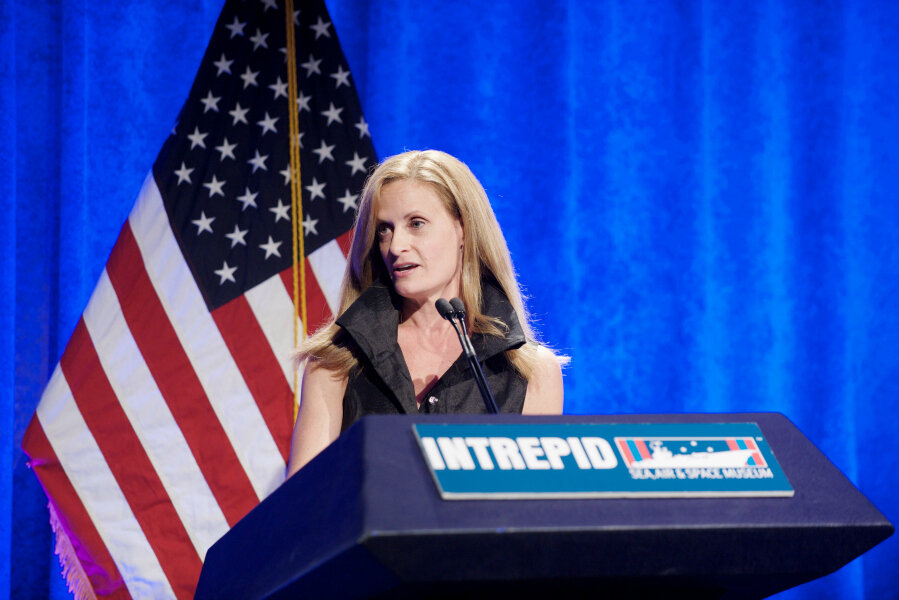A World War II aircraft carrier's new mission: promote science education
Loading...
| New York
That the NASA space shuttle Enterprise sits on the flight deck of the Intrepid Sea, Air & Space Museum is no small point of pride for its president, Susan Marenoff-Zausner.
Indeed the shuttle symbolizes the museum’s mission: to use history as a platform to propel future generations forward. As the first woman and non-military person to helm the nonprofit cultural and educational institution since it opened in 1982, Ms. Marenoff-Zausner wants today's students to be bold, innovative, and daring – just like the Enterprise.
“We are privileged to have all of this 'cool stuff' – our artifacts such as planes, and propellers, and collections such as diaries and other personal items of actual former crew members to excite our children about learning,” Marenoff-Zausner says. “This ‘stuff’ helps to teach them about the past and connect them to the present and the future.”
Before she came to the Intrepid in 2003 Marenoff-Zausner was general manager of the NY Power team in the Women’s United Soccer Association. Then the league folded and she lost her job. Soon after a headhunter asked her to interview for the position of chief marketing officer of the Intrepid museum. She became executive director in 2005 and president in 2011.
“It took a little while to realize what I was missing. I realized the ship is your team, and you still have to market it,” she says sitting in her office, which is directly below the flight deck of the storied aircraft carrier.
As Marenoff-Zausner sees it, the museum’s largest asset – aside from its 28 restored aircraft aboard the decommissioned World War II aircraft carrier USS Intrepid – lies in its ability to foster an interest in STEM, or science, technology, engineering and math.
To that end Marenoff-Zausner and her team run 800 educational programs.
Many, such as LIFT (Leadership Institute for Today and Tomorrow) and GOALS (Greater Opportunities Advancing Leadership in Science) are specifically geared for underserved children. The former is for 11th graders; the latter is a six-week program where leaders in STEM fields mentor girls.
“Girls drop out of engineering after one year, not because they’re not good at it, but because they’re afraid they won’t succeed,” she says. “If we can change that, if we can show girls that they can succeed they will stay with it."
Another program highlight was the Intrepid International Space Station Challenge, a joint partnership between the Intrepid museum, the Student Spaceflight Experiments Program, and the Ramon Foundation.
Last spring, 200 middle school students from five New York City public schools competed to get their experiment flown to the International Space Station.
The winning team was comprised of five sixth-grade students from PS/IS 30 Mary White Ovington in Brooklyn, N.Y.. Their experiment explored how microgravity affects the germination of seeds.
The challenge grew from the rapport between Marenoff-Zausner and Rona Ramon, the widow of Ilan Ramon, the first Israeli astronaut who died in the 2003 Colombia shuttle accident. Their first-born son Asaf, an F-16 fighter pilot, was killed in a 2009 training mission. Ramon founded the Ramon Foundation to honor their legacies.
Additionally 180 programs are designed to ensure no visitor is left behind.
There are three new programs aimed at returning veterans with post-traumatic stress disorder. There are programs for children with developmental or learning disabilities. Additionally the Intrepid runs a host of programs for the sight impaired or hearing impaired.
Keenly aware of the attachment those who served on the USS Intrepid feel about the carrier, Marenoff-Zausner continuously thinks of ways to honor and include those veterans.
“I recognize how important this particular place is, how important these steel walls are for the men who served,” she says.
When the ship marked the 70th Former Member Crew Reunion in 2013, Marenoff-Zausner had pieces of the original wooden flight deck sanded, polished, and fitted with plaques. Children presented the pieces to the 12 crew members that were aboard the carrier on the first day of its commission, Aug. 16, 1943.
“My soft spot is the elderly and kids,” Marenoff-Zausner says. “I do get very emotional about this place. We impact a lot of people every day.”
• Learn more at www.intrepidmuseum.org.





